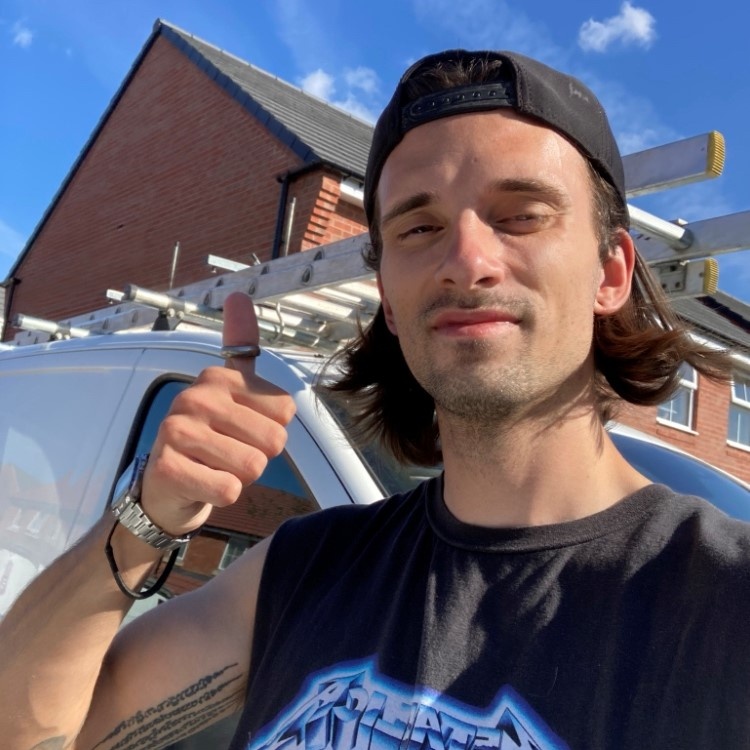Sid Partridge, owner of Partridge Exterior Cleaning based in Burton-upon-Trent, talks to Small Business about setting up his YouTube channel. We find out how he boosts audience engagement and reached 68.3k subscribers within a year.
What made you start a YouTube channel for your company?
Basically, I had quite a successful business where I was living previously. I was there for quite a few years building a reputation. But I moved pretty quickly. It meant that I had to restart my business all over again. I was really struggling as I couldn’t charge as much as I did. I was really struggling to get the work and I was spending hundreds of pounds in advertising. It wasn’t really working.
I thought, ‘Right, I’ll try and make some YouTube videos at least and say, If I clean someone’s driveway, for example, then I’ll have video proof of me doing it’. Then if someone else with a similar driveway in the future is inquiring and thinking, ‘I want it done, but I’m not sure if I want to pay. I don’t know what it’s going to look like afterwards’, because my prices are quite expensive. I could show them that video. And then I could say, ‘Well, that’s an identical driveway to yours. That’s how yours is going to look when it’s done’. Because it’s the same type of stone as that one, for example.
>See also: How to create a YouTube channel for your small business
What kind of equipment did you use when you’re starting out? And how does that compare to now?
Well, I started out just with a £20 tripod. I used that up until I had about 15,000 subscribers to be honest with you. I think both of the videos I’ve done that were over a million views are just filmed on an iPhone. Now I’ve got a GoPro and I’ve got a tripod.
How much did you pay in total for the equipment you had when you were starting out?
I downloaded some editing software, which costs around £18 a month. I’d probably say under £50.
Your channel seems to have grown massively since it was launched. What tips do you have for readers about maximising reach and engagement?
Consistency is pretty much the single biggest thing. Obviously, the quality needs to be good, making sure the video isn’t too drawn out, in a sense. If you’re going to do a job, it’s good to have some parts real-time and some parts time lapse, for example. Just keep uploading videos – try and aim for around two a week – as many as you can possibly do while keeping the same quality. Then finally just injecting some personality into it because people will subscribe for pretty much anything. But you’ll get a lot more returning subscribers if they like you as a person because a lot don’t even care what job you’re doing. They just want to see you talk.
On average, how long per week do you put into managing your YouTube channel?
I aim for two to three videos a week but it’s not always possible. Usually it will be probably two videos, including the actual job as well as me filming the job so it’s a normal eight-hour work day per video. That’s 16 hours and then it probably takes me about four hours to edit each video. In total, around 20-24 hours a week.
How long are your videos?
I’ve found that ten minutes is good for videos. I always find that retention drops after about 25 minutes. I usually aim for between ten and 20 minutes, but I have to – if I didn’t cut down so much, my videos would be two hours long!
When you’re filming on location, do you have to get permission from the owner of the property?
I always ask my customers if I can film the job. I’ll never say what road the property is on or anything like that. I’d say that it’s fine 99 per cent of the time. But every now and again, I’ve got what would have been an amazing job and they’ve said no. Whereas the schoolwork and stuff, when I send emails out to try and get those jobs in, I always have it as a stipulation on the emails as I’ll do a reduced rate or do the job for free, as long as I can film some promotional videos for the business.
How long had you been making videos before you noticed the real surge in subscribers?
It was just after I monetised, which was in April. I’d been making videos since the start of October 2020. Then I had sort of a steady growth, I’d get 100 subscribers a month. Then I had two videos go semi-viral at the same time, which was around that April. It just went from there.
Who is your core audience?
It’s split pretty much 50/50, with the first 50 per cent of the people from the UK which are people in the industry themselves, because I do quite a varied amount of cleaning. I get a lot of the people that clean rooms, a lot of people that pressure wash and a lot of people that clean windows, or want to try it. The other 50 per cent – this is going to sound weird – but it’s American housewives. I think in America it’s, you know, the oddly satisfying stuff?
You’ve used YouTube’s live stream feature. What purpose does it serve in your content creation?
I found whenever you get like an initial surge of subscribers, maybe a video starts doing really well. It depends on the size of the channel. You could go from getting one subscriber a day to all of a sudden having 30 and I always think after you get a big surge, it’s always handy doing a live stream to properly introduce yourself to those new people in a way.
You do have a lot of varied content. Where do you tend to get your ideas from?
The vast majority of my early videos and more recent videos as well, they’ve just been focused on the jobs I’ve been doing, there’s not really much I can think of to do other than that. And people like seeing it. Then I was starting to see what was working and what people like to see. I just tried to capitalise on that, basically, it’s a lot of people like the free claims, and me cleaning my playgrounds and stuff like that. So that’s something that I actively went searching for to try and make more videos on it. I actually do a lot of these jobs for free now, because I made the money that I would have charged anyway, just off the video. It’s a win-win.
Did you know much about the algorithm when you were starting on YouTube or is not a big deal for you?
To be honest, I’m not an expert on it at all. But I really struggled with identifying how to make something do well. It always seems so random to me. I could put my heart and soul into a video and think this is the best thing I’ve ever done, then it gets around 20,000 views. It sounds a lot, but it’s not in terms of a video that obviously does really well. There are some videos that I’ve done, which I didn’t think anything of, that end up getting 500,000 or 1m views. I can’t understand that. I don’t know, there must be a trick to it.
I’ve been on YouTube since it came out. I’ve had many, many YouTube channels, none have done as well as this. But I already had the core basic styling of making sure the video is edited, making sure the thumbnail looks good and having this kind of ambiguous, engaging title where possible.
I think you do a really good job of thumbnails as well to provide some extra text and some extra info in there.
Yeah, I mean, I’ll try my best. Then you scroll down YouTube and you see a video with 50m views and it could just be a really bad quality picture of a tree. I think as long as you do the core things, it’s only a matter of time before you start to do well.
What proportion of your income is from the work itself versus what you would get from the YouTube channel?
It’s hard to say because, being self-employed anyway, your income can vary because I don’t have regular customers. If I clean a school and the video gets 250,000 views within the first month, I will probably have made double, if not triple the amount from the video than I would have if I’d charged for the job. It’s quite lucrative to do. I could charge for it as well and it’d be even more money, but it just secures the job more easily if I say that I’ll do it for free, because I’ll film a video of it. It stops me from being greedy.
Would you consider yourself a YouTuber?
It’s tough one, to be honest. I’d say no. Maybe in the future but I’ve got no plans. I would like to, because it can pay well. So, I’m always going to have to work to make videos. I could slowly phase out the cleaning if the YouTube continues to do well, and I can do less work and more videos about other things. I’d like to buy a house one day and fix it up. I’ll do a series on that. I’m just trying to transition through life with the channel as well.
>See also: How to get started with brand partnerships on YouTube
But you never know – it’s a huge risk to take. Because I’ve noticed it before, even uploading sort of a few different types of videos in a row other than the ones that do really well. It could have been going from 200,000 views every four hours, straight down to 30,000 views. A huge drop.
The main thing is that nothing is guaranteed, so I’ll just enjoy what I can. I think you need a very sizable audience and some really good funds before you could even consider becoming reliant on your YouTube income basically, because it can just literally flip a switch overnight.





